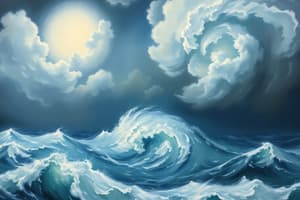Podcast
Questions and Answers
What is cyclonic rainfall primarily caused by?
What is cyclonic rainfall primarily caused by?
- Warm air meeting cold air (correct)
- Heavy snowfall
- Ground water absorption
- Evaporation from rivers
Cool air and warm air will mix easily when they meet.
Cool air and warm air will mix easily when they meet.
False (B)
What is the primary source of water on Earth?
What is the primary source of water on Earth?
Oceans
The process through which water vapor in the air condenses to form clouds is known as __________.
The process through which water vapor in the air condenses to form clouds is known as __________.
Match the following terms with their descriptions:
Match the following terms with their descriptions:
What happens to the water that is not absorbed by plants and soil?
What happens to the water that is not absorbed by plants and soil?
Name two forms of precipitation that water can come down as.
Name two forms of precipitation that water can come down as.
Flashcards are hidden until you start studying
Study Notes
Cyclonic Rainfall
- Known as frontal rainfall, occurs when two air masses with different temperatures meet.
- Warm air rises over cooler, denser air, forming a front where cooling occurs.
- Cooling leads to condensation, resulting in the formation of clouds and subsequent rainfall.
Water Cycle
- Oceans serve as the primary source of water on Earth.
- Water evaporates from oceans, soil, plants, and other surfaces, entering the atmosphere as vapor.
- Atmospheric water vapor condenses into clouds due to temperature changes.
- Winds from the ocean transport moisture-laden clouds across land.
- Precipitation occurs primarily as rain or snow over land, replenishing the soil and plant life.
- Water that is not absorbed runs off into rivers and streams, a process known as surface runoff.
- Surface runoff eventually flows back into oceans, completing the cycle.
- The water cycle represents the continuous movement and transformation of water through Earth's various systems: oceans, land, and atmosphere.
Studying That Suits You
Use AI to generate personalized quizzes and flashcards to suit your learning preferences.


